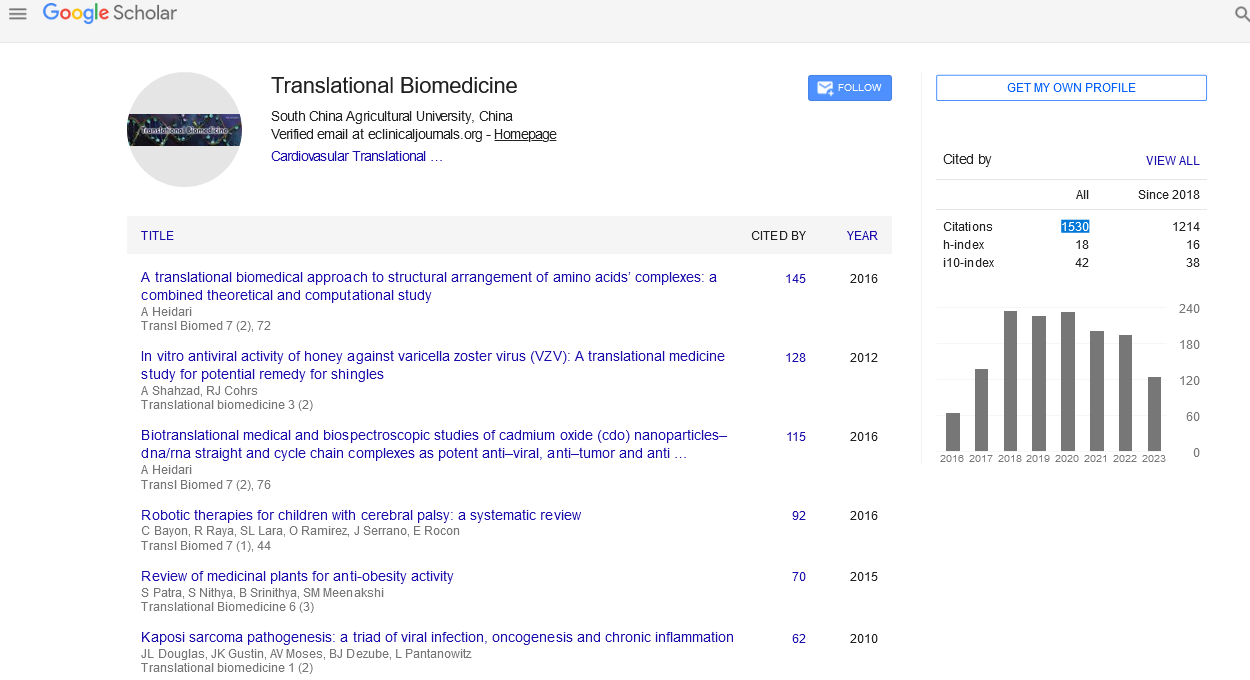Perspective - (2024) Volume 15, Issue 2
Unlocking the Potential: Pharmaceutical and Biotechnological Applications of Lignin-based Materials
Terry Aspray*
Department of Biotechnology, Golas University, Recife, Brazil
*Correspondence:
Terry Aspray, Department of Biotechnology, Golas University, Recife,
Brazil,
Email:
Received: 06-Mar-2024, Manuscript No. IPTB-24-14646;
Editor assigned: 11-Mar-2024, Pre QC No. IPTB-24-14646 (PQ);
Reviewed: 25-Mar-2024, QC No. IPTB-24-14646;
Revised: 02-Apr-2024, Manuscript No. IPTB-24-14646 (R);
Published:
10-Apr-2024
Introduction
Lignin, often considered as a byproduct of the paper and pulp
industry, has long been overlooked and underutilized. However,
recent advancements in technology and sustainable practices
have shed light on the incredible potential of lignin-based
materials in various industries, particularly pharmaceuticals and
biotechnology. This abundant and renewable resource, derived
from plant cell walls, is now being recognized for its unique
properties and applications that can revolutionize these sectors.
Description
Understanding lignin
Lignin is a complex and heterogeneous polymer found in the
cell walls of plants. Traditionally discarded during the paper and
pulp production process, lignin has emerged as a valuable
resource for its remarkable chemical structure and diverse
functionalities. Comprising phenolic compounds, lignin provides
strength to plant cell walls, contributing to their rigidity and
resilience.
The challenges of lignin utilization
Despite its abundant availability, lignin has presented
challenges in terms of its extraction and modification. Its
complex structure and variability between plant species make it
difficult to obtain a consistent quality of lignin. However, recent
advancements in extraction technologies and sustainable
practices have made significant strides in overcoming these
challenges, opening doors to new possibilities in lignin-based
materials.
Lignin-based materials in pharmaceuticals
Drug delivery systems: Lignin-based materials have been
investigated for their potential as drug delivery systems due to
their biocompatibility, biodegradability and ability to
encapsulate and release Active Pharmaceutical Ingredients
(APIs) in a controlled manner. Lignin nanoparticles,
microparticles and hydrogels can be used to encapsulate drugs
and deliver them to specific targets in the body.
Lignin nanoparticles, in particular, have shown promise for
delivering both hydrophobic and hydrophilic drugs. These
nanoparticles can be easily functionalized with targeting ligands
or surface modifications to enhance their specificity and
efficacy. Additionally, lignin-based hydrogels can be used as
injectable drug delivery systems for localized and sustained
release of therapeutics.
Antioxidant properties: The phenolic compounds present in
lignin exhibit antioxidant properties, which are highly beneficial
in pharmaceutical formulations. Antioxidants play a crucial role
in preventing oxidative stress-related diseases. Lignin-based
antioxidants can be incorporated into medications to enhance
their efficacy and protect sensitive compounds from
degradation.
Wound healing applications: Lignin-based materials have also
been investigated for their potential in wound healing
applications. Lignin nanoparticles and hydrogels have shown
antibacterial properties, which can help prevent infection and
promote wound healing. Additionally, lignin-based scaffolds can
provide a three-dimensional structure for cell attachment and
proliferation, making them suitable for tissue engineering
applications.
Researchers have explored the use of lignin-based materials
for the development of wound dressings and skin substitutes.
These materials can be loaded with growth factors or other
bioactive molecules to promote tissue regeneration and
accelerate wound healing. Furthermore, lignin-derived
nanoparticles have been shown to have antioxidant properties,
which can help reduce inflammation and oxidative stress at the
wound site.
Biotechnological applications of lignin-based
materials
Biocompatible scaffolds for tissue engineering: Ligninderived
materials can be processed into biocompatible scaffolds,
providing a three-dimensional structure for cell growth and
tissue regeneration. These scaffolds mimic the natural
extracellular matrix, promoting cellular adhesion and
proliferation. The porous nature of lignin-based scaffolds allows
for nutrient and oxygen diffusion, critical for successful tissue
engineering.
Biodegradable plastics: The growing concern over plastic
pollution has led to increased interest in biodegradable
alternatives. Lignin, with its natural abundance and
biodegradability, can be utilized in the production of
biodegradable plastics. Blending lignin with other biopolymers
results in materials with reduced environmental impact, opening
avenues for sustainable packaging solutions.
Enzyme immobilization: Lignin's unique structure offers a
platform for enzyme immobilization, a crucial aspect in various
biotechnological processes. Immobilized enzymes have
enhanced stability and reusability, leading to more efficient
biocatalysis. Lignin-derived materials can serve as
immobilization matrices, providing a stable environment for
enzymes in applications ranging from biofuel production to food
processing.
Challenges and future prospects
While lignin-based materials show great promise in
pharmaceutical and biotechnological applications, several
challenges need to be addressed to realize their full potential.
One major challenge is the variability in lignin composition and
properties depending on the source and extraction method.
Standardization of lignin extraction and processing methods is
essential to ensure consistent quality and performance of ligninbased
materials.
Furthermore, more research is needed to optimize the
properties of lignin-based materials for specific applications.
This includes fine-tuning the degradation kinetics, mechanical
properties and surface chemistry of lignin-derived polymers to
meet the requirements of different biomedical applications.
Additionally, the scalability and cost-effectiveness of lignin
extraction and processing methods need to be improved to
enable commercialization and widespread adoption of ligninbased
materials.
Standardization and quality control: Achieving consistent
quality in lignin-based materials remains a challenge due to the
inherent variability of lignin from different plant sources.
Standardization and quality control measures are essential for
ensuring the reliability and reproducibility of lignin-derived
products in pharmaceutical and biotechnological applications.
Scale-up and cost-effectiveness: While research has shown
the potential of lignin-based materials, scaling up production
and ensuring cost-effectiveness are crucial for their widespread
adoption. Innovations in extraction technologies and sustainable
sourcing practices are necessary to make lignin-based materials
economically viable on an industrial scale.
Regulatory approval: Regulatory approval is a critical step for
the commercialization of lignin-based pharmaceutical and
biotechnological products. Ensuring the safety and efficacy of
these materials requires adherence to regulatory standards,
which may involve extensive testing and validation processes.
Conclusion
Lignin-based materials are emerging as versatile and
sustainable alternatives in the pharmaceutical and
biotechnological realms. From drug delivery systems to tissue
engineering scaffolds, lignin's unique properties hold promise
for addressing various challenges in these industries. As
technology continues to advance and researchers overcome
current limitations, lignin's potential is poised to revolutionize
the way we approach drug development, medical applications
and biotechnological processes. The integration of lignin-based
materials into mainstream practices represents not only a
significant step towards sustainability but also a testament to
the untapped potential of nature's resources in shaping the
future of pharmaceuticals and biotechnology.
Citation: Aspray T (2024) Unlocking the Potential: Pharmaceutical and Biotechnological Applications of Lignin-based Materials. Transl Biomed.
Vol. 15 No.2: 012





